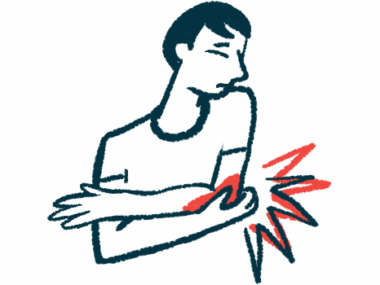RDEB patient undergoes safe gold weight implant in eyelids: Report
Woman, 49, complained of eye pain, worsening vision
Written by |

Gold weight implants were safely implanted under the eyelids of a woman with recessive dystrophic epidermolysis bullosa (RDEB), according to a recent report.
Despite their limited effectiveness in reducing her difficulties completely closing her eyelids — a condition called lagophthalmos — the “safety and tolerability of the gold weight implants in this case is encouraging,” the researchers wrote.
“This case highlights that with appropriate perioperative care and careful surgical technique, upper eyelid loading procedures can be performed safely in individuals with EB,” they wrote in the report, “Gold weight implants for cicatricial lagophthalmos in epidermolysis bullosa,” which was published in Clinical and Experimental Dermatology.
People with RDEB have two mutated copies of the COL7A1 gene, one from each parent. COL7A1 contains the instructions for a portion of the type VII collagen protein, which connects the layers of the skin. RDEB patients have fragile skin that blisters easily in response to minor injuries, rubbing, or scratching.
The eyes can be affected in RDEB, with scarring of the cornea — the transparent front part of the eye that allows light to enter — and vision loss being possible.
Researchers in Australia describe the case of a 49 year-old woman with severe RDEB that affected her vision. The woman complained of worsening eye pain and vision. Since adolescence, she had dry eye and lagophthalmos in both eyes.
She had a hard time using eyedrops due to pseudosyndactyly, an EB-related hand deformity that affected her dexterity.
An eye examination revealed impaired visual acuity, as well as lagophthalmos with tight and shortened upper lid skin.
The woman had mild to moderate chronic exposure keratopathy — damage to the cornea due to prolonged exposure to the outside — along with erosions in the front of the eye, and new blood vessels. She also showed scarring and early cataracts, or clouding of the eye lens.
The fluid pressure in the eyes, or intraocular pressure, was elevated at 23 mmHg. The normal range is between 10 to 20 mmHg.
To help her close her eyes and reduce the keratopathy, her medical team opted for gold weight implants to both upper eyelids after rejecting other ideas, including a tarsorrhaphy and upper eyelid lowering, which could have impaired her vision even more. A tarsorrhaphy involves suturing the eyelids together to protect the cornea.
The surgery was performed under a local anesthetic and a 1.4 g gold weight was placed at the upper border of each tarsal plate, the main structural component of the eyelids, made of dense connective tissue.
Given the underlying skin fragility in EB, the clinicians said they took special care to reduce the risk of affecting the surrounding tissues.
The implants were well tolerated. A two-year follow-up showed no signs of the them moving, ulceration (a break on the surface of an organ), or other side effects.
The patient reported only a slight reduction of eye symptoms. Her eyelid closure improved, however, as did the appearance of her cornea. Corneal staining – a dye to assess cornea damage – showed some areas that had been previously positive for staining, indicating damage, were now negative.
“This invasive strategy may be worth considering in patients with EB and other conditions where cicatricial lagophthalmos poses a risk for significant exposure keratopathy,” the authors said.






